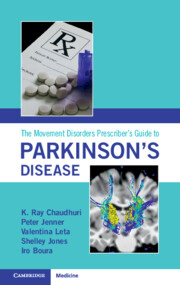Book contents
- The Movement Disorders Prescriber’s Guide to Parkinson’s Disease
- Reviews
- The Movement Disorders Prescriber’s Guide to Parkinson’s Disease
- Copyright page
- Contents
- Foreword
- Abbreviations
- Introduction
- Amantadine
- Amitriptyline
- Apomorphine Hydrochloride Subcutaneous Infusion
- Apomorphine Hydrochloride Subcutaneous Injection
- Apomorphine Hydrochloride Sublingual Film
- Botulinum Toxin
- Citalopram
- Clonazepam
- Clozapine
- Desipramine
- Domperidone
- Donepezil
- Droxidopa
- Entacapone
- Fludrocortisone
- Glycopyrrolate
- Istradefylline
- Levodopa–Benserazide
- Levodopa–Carbidopa
- Levodopa–Carbidopa Intestinal Gel
- Levodopa–Carbidopa–Entacapone Intestinal Gel
- Levodopa, Inhaled
- Lubiprostone
- Macrogol
- Melatonin
- Memantine
- Midodrine
- Mirabegron
- Mirtazapine
- Modafinil
- Naltrexone
- Nortriptyline
- Opicapone
- Oxybutynin
- Pimavanserin
- Piribedil
- Pramipexole*
- Quetiapine
- Rasagiline
- Rivastigmine
- Ropinirole
- Rotigotine
- Safinamide
- Selegiline
- Sildenafil
- Solifenacin
- Tolcapone
- Tolterodine
- Trihexyphenidyl
- Venlafaxine
- Zonisamide
- Levodopa Dose Equivalence in Parkinson’s
- Subcutaneous Foslevodopa Foscarbidopa infusion
- Index
- References
Amitriptyline
Published online by Cambridge University Press: 20 February 2025
- The Movement Disorders Prescriber’s Guide to Parkinson’s Disease
- Reviews
- The Movement Disorders Prescriber’s Guide to Parkinson’s Disease
- Copyright page
- Contents
- Foreword
- Abbreviations
- Introduction
- Amantadine
- Amitriptyline
- Apomorphine Hydrochloride Subcutaneous Infusion
- Apomorphine Hydrochloride Subcutaneous Injection
- Apomorphine Hydrochloride Sublingual Film
- Botulinum Toxin
- Citalopram
- Clonazepam
- Clozapine
- Desipramine
- Domperidone
- Donepezil
- Droxidopa
- Entacapone
- Fludrocortisone
- Glycopyrrolate
- Istradefylline
- Levodopa–Benserazide
- Levodopa–Carbidopa
- Levodopa–Carbidopa Intestinal Gel
- Levodopa–Carbidopa–Entacapone Intestinal Gel
- Levodopa, Inhaled
- Lubiprostone
- Macrogol
- Melatonin
- Memantine
- Midodrine
- Mirabegron
- Mirtazapine
- Modafinil
- Naltrexone
- Nortriptyline
- Opicapone
- Oxybutynin
- Pimavanserin
- Piribedil
- Pramipexole*
- Quetiapine
- Rasagiline
- Rivastigmine
- Ropinirole
- Rotigotine
- Safinamide
- Selegiline
- Sildenafil
- Solifenacin
- Tolcapone
- Tolterodine
- Trihexyphenidyl
- Venlafaxine
- Zonisamide
- Levodopa Dose Equivalence in Parkinson’s
- Subcutaneous Foslevodopa Foscarbidopa infusion
- Index
- References
Summary
Amitriptyline hydrochloride (3-(10,11-dihydro-5H-dibenzo[a,d]cycloheptene-5-ylidene)-N,N-dimethylpropan-1-amine; hydrochloride) has a molecular weight of 313.9 and a molecular formula of C20H23N,HCl. Amitriptyline is usually given as the hydrochloride and doses are expressed in terms of this salt. Amitriptyline hydrochloride 75 mg is equivalent to about 66.3 mg of the base.
- Type
- Chapter
- Information
- Publisher: Cambridge University PressPrint publication year: 2025

